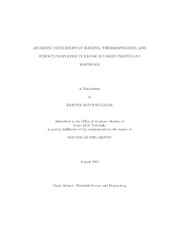| dc.contributor.advisor | Cagin, Tahir | |
| dc.creator | Williams, Kristen | |
| dc.date.accessioned | 2012-10-19T15:30:43Z | |
| dc.date.accessioned | 2012-10-22T18:02:32Z | |
| dc.date.available | 2014-11-03T19:49:14Z | |
| dc.date.created | 2012-08 | |
| dc.date.issued | 2012-10-19 | |
| dc.date.submitted | August 2012 | |
| dc.identifier.uri | https://hdl.handle.net/1969.1/ETD-TAMU-2012-08-11720 | |
| dc.description.abstract | Engineering new solid propellant materials requires optimization of several factors, to include energy density, burn rate, sensitivity, and environmental impact. Equally important is the need for materials that will maintain their mechanical properties and thermal stability during long periods of storage. The nanoscale materials considered in this dissertation are proposed metal additives that may enhance energy density and improve combustion in a composite rocket motor. Density Functional Theory methods are used to determine cluster geometries, bond strengths, and energy densities.
The ground-state geometries and electron affinities (EAs) for MnxO?: x = 3, 4, y = 1, 2 clusters were calculated with GGA, and estimates for the vertical detachment energies compare well with experimental results. It was found that the presence of oxygen influences the overall cluster moment and spin configuration, stabilizing ferrimagnetic and antiferromagnetic isomers. The calculated EAs range from 1.29-1.84 eV, which is considerably lower than the 3.0-5.0 eV EAs characteristic of current propellant oxidizers. Their use as solid propellant additives is limited.
The structures and bonding of a range of Al-cyclopentadienyl cluster compounds were studied with multilayer quantum mechanics/molecular mechanics (QM:MM) methods. The organometallic Al-ligand bonds are generally 55-85 kcal/mol and are much stronger than Al-Al interactions. This suggests that thermal decomposition in these clusters will proceed via the loss of surface metal-ligand units. The energy density of the large clusters is calculated to be nearly 60% that of pure aluminum. These organometallic cluster systems may provide a route to extremely rapid Al combustion in solid rocket motors.
Lastly, the properties of COOH-terminated passivating agents were modeled with the GPW method. It is confirmed that fluorinated polymers bind to both Al(111) and Al(100) at two Al surface sites. The oligomers HCOOH, CH3CH2COOH, and CF3CF2COOH chemisorb onto Al(111) with adsorption energies of 10-45 kcal/mol. The preferred contact angle for the organic chains is 65-85 degrees, and adsorption energy weakens slightly with increasing chain length. Despite their relatively weak adsorption energies, fluorinated polymers have elevated melting temperatures, making them good passivation materials for micron-scale Al fuel particles. | en |
| dc.format.mimetype | application/pdf | |
| dc.language.iso | en_US | |
| dc.subject | materials science | en |
| dc.subject | solid propellants | en |
| dc.subject | organometallics | en |
| dc.subject | ab initio calculations | en |
| dc.subject | antiferromagnetic materials | en |
| dc.subject | ferrimagnetic materials | en |
| dc.subject | ground states | en |
| dc.subject | isomerisation | en |
| dc.subject | magnetic moments | en |
| dc.subject | magnetic structure | en |
| dc.subject | manganese compounds | en |
| dc.subject | molecular clusters | en |
| dc.subject | photoelectron spectra | en |
| dc.subject | chemisorption | en |
| dc.subject | dispersion interactions | en |
| dc.subject | carboxylates | en |
| dc.subject | surface passivation | en |
| dc.subject | thermodynamics | en |
| dc.subject | density functional theory | en |
| dc.title | Atomistic Simulations of Bonding, Thermodynamics, and Surface Passivation in Nanoscale Solid Propellant Materials | en |
| dc.type | Thesis | en |
| thesis.degree.department | Chemical Engineering | en |
| thesis.degree.discipline | Materials Science and Engineering | en |
| thesis.degree.grantor | Texas A&M University | en |
| thesis.degree.name | Doctor of Philosophy | en |
| thesis.degree.level | Doctoral | en |
| dc.contributor.committeeMember | Arroyave, Raymundo | |
| dc.contributor.committeeMember | Petersen, Eric | |
| dc.contributor.committeeMember | Ross, Joseph | |
| dc.contributor.committeeMember | Sinova, Jairo | |
| dc.type.genre | thesis | en |
| dc.type.material | text | en |
| local.embargo.terms | 2014-10-22 | |


